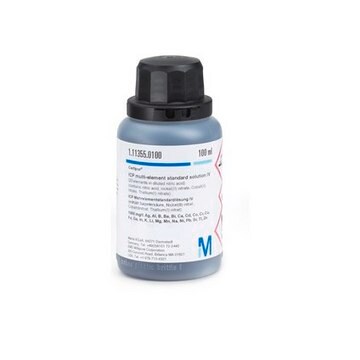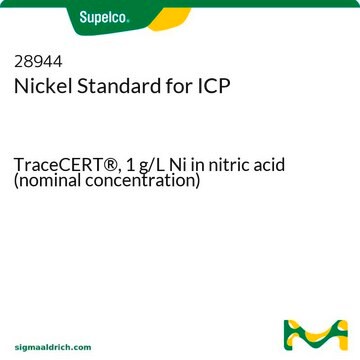01969
Arsenic Standard for ICP
TraceCERT®, 1 g/L As in nitric acid (nominal concentration)
About This Item
Recommended Products
grade
certified reference material
TraceCERT®
Quality Level
product line
TraceCERT®
concentration
1 g/L As in nitric acid (nominal concentration)
technique(s)
ICP: suitable
application(s)
agriculture
cleaning products
cosmetics
food and beverages
personal care
format
single component solution
General description
Please visit ISO certificates and Site Quality Self-Assessments to access the current certificates of accreditation.
Download your certificate at http://www.sigma-aldrich.com to view certified values, including uncertainty, date of expiry, and detailed information about trace impurities.
Application
Analysis Note
Other Notes
Legal Information
Signal Word
Danger
Hazard Statements
Precautionary Statements
Hazard Classifications
Carc. 1A - Eye Dam. 1 - Met. Corr. 1 - Skin Irrit. 2
Storage Class Code
6.1D - Non-combustible acute toxic Cat.3 / toxic hazardous materials or hazardous materials causing chronic effects
WGK
WGK 3
Flash Point(F)
Not applicable
Flash Point(C)
Not applicable
Personal Protective Equipment
Regulatory Listings
Regulatory Listings are mainly provided for chemical products. Only limited information can be provided here for non-chemical products. No entry means none of the components are listed. It is the user’s obligation to ensure the safe and legal use of the product.
PDSCL
Poisonous substance
ISHL Indicated Name
Substances Subject to be Indicated Names
ISHL Notified Names
Substances Subject to be Notified Names
JAN Code
01969-BULK-F:
01969-100ML-F:4548173241685
01969-100ML-BULK-F:
01969-VAR-F:
Choose from one of the most recent versions:
Already Own This Product?
Find documentation for the products that you have recently purchased in the Document Library.
Customers Also Viewed
Articles
Testing for heavy metals in food and beverages? You understand that prolonged trace exposure to heavy metals such as arsenic (As), cadmium (Cd), chromium (Cr), lead (Pb), mercury (Hg), and thallium (Tl), via the food, beverages and drinking water we consume can cause serious health risks. Fortunately, increasingly sensitive tests are in place to ensure our food is safe. Discover the recent advances in analytical technologies for heavy metal detection and the products, services and technical support available to help you keep us all safe. Because we all want to trust what we eat.
Our team of scientists has experience in all areas of research including Life Science, Material Science, Chemical Synthesis, Chromatography, Analytical and many others.
Contact Technical Service

















